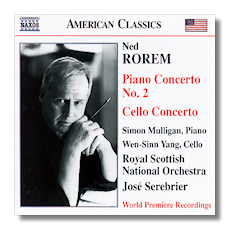
The Internet's Premier Classical Music Source
Related Links
- Rorem Reviews
- Latest Reviews
- More Reviews
-
By Composer
-
Collections
DVD & Blu-ray
Books
Concert Reviews
Articles/Interviews
Software
Audio
Search Amazon
Recommended Links
Site News
 CD Review
CD Review
Ned Rorem

Concertos
- Piano Concerto #2
- Cello Concerto
Simon Mulligan, piano
Wen-Sinn Yang, cello
Royal Scottish National Orchestra/José Serebrier
Naxos 8.559315 DDD 59:18
As a composer, Ned Rorem (b. 1923) is hardly a dedicated follower of fashion, and it says something about his stylistic consistency that these two scores, which are separated by 51 years, are clearly the work of the same man. This is modern music at its most consonant, and of which no one need be wary. The Piano Concerto #2 was completed in 1951 for no less than Julius Katchen. After a successful première, it was neglected for decades. The Cello Concerto dates from 2002. Both works receive their first recordings with this CD.
I confess that I've been familiar with Rorem's published diaries for longer than I've been familiar with his music. In fact, the sometimes regal tone of his diaries put me off his music, and it's only recently that I've learned that Rorem the composer is much easier to take than Rorem the diarist. He writes music that is important but not self-important, and the worst complaint that I can make is that he, like Benjamin Britten, sometimes lets his cleverness get in the way of making a direct connection with his listeners. This new Cello Concerto, for example, is in eight movements, with titles such as "Three Queries, One Response" and "Valse Rappelée" – a play, it seems, on one of Liszt's Valses oubliées. In "A Single Tone, A Dozen Implications," the cello holds an E throughout the movement's 1:27 while the orchestra surrounds it with "a sequence of twelve colors in varied intensities" (in Rorem's own words). I was reminded of the interlude near the end of Billy Budd that Britten constructs from a series of bare orchestral chords succeeding each other evenly as if in a procession. It's a neat idea, but it does tend to shout out, "What a neat idea this is!"
The Piano Concerto #2 was composed in Morocco, and wears its French influences proudly. Indeed, there are passages in the first movement that would not be out of place in Ravel's Piano Concerto in G, while others are reminiscent of Leonard Bernstein. While there are introspective sections, the prevailing tone of this concerto is witty and conversational, as if the pianist were at a smart cocktail party and found himself to be the center of attention. Soloist Simon Mulligan can bear this kind of scrutiny. With his light touch and well-articulated playing, he seems ideally suited to this concerto.
Wen-Sinn Yang is more reticent in the Cello Concerto, but this is a more reticent work, its clever movement titles not withstanding. Somehow, the concerto never feels like a suite, and never loses its momentum over the course of 25 minutes. The quiet ending is a surprise. In the end, one is left with a strong feeling of admiration for this concerto, although I can't say that it inspires the same amount of excitement as its disc-mate.
Serebrier is a passionate advocate for Rorem's music – he even wrote the booklet notes – and the Royal Scottish National Orchestra is in excellent form. The engineering helps too.
Copyright © 2008, Raymond Tuttle




















